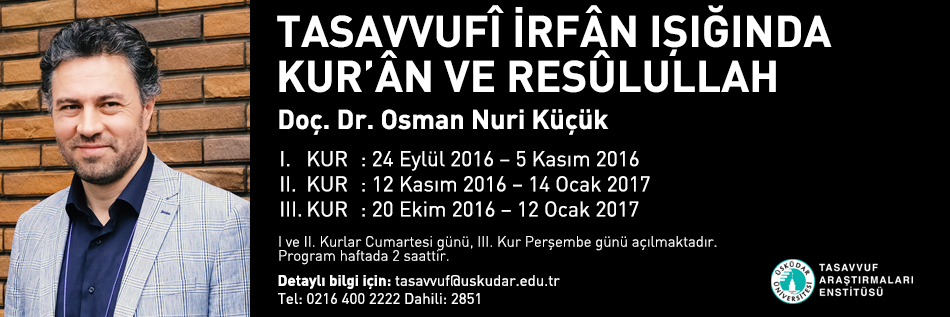
QUR’AN AND THE PROPHET MUHAMMAD IN LIGHT OF SUFI WISDOM
FOR THE REGISTRATION ANNOUNCEMENT PLEASE CLICK HERE
SCOPE
The religion of Islam must be expressed with just the word Islam without any qualifications. But people’s conception of religion, including the period of the Prophet Muhammad (pbuh), has always been appropriate to their own level. Among the first believers, there was a difference of style, disposition, and depth in belief.
Each of the sciences of religion has interpreted Islam and its two main sources from their own viewpoint. While the examined words may look the same, the comments and meanings differ according to the method of each discipline. What a theologian (kelam) understands and relates of religion differs from that of a philosopher, a commentator, a jurisprudent, or a preacher; it is a way of commenting on religion. Assumed to be the same, the difference is in quality. This difference is appropriate to the nature of humanity with its different specialties—to put it in religious terms, it is appropriate to the divine wish.
Islamic Sufism is rooted fundamentally in the Prophet Muhammad (pbuh). But due to the importance given by him to the common human experience, there is an attempt to understand him through nourishment from the tradition of wisdom coming from the saints, mystics and sages of many societies whose races and languages are different. This understanding is related to other religious sciences. But it has a sui generis cognizance. The tradition of Sufi wisdom has an amazing cultural heritage based on the Qur’an and the sunna of the Prophet Muhammad with a deep experience that comments on its data. This class examines Sufi thinkers’ methods and principles on their conception of revelation and the Prophet Muhammad by benefiting from the sources on this topic.
This program is organized as successive semesters. In the first semester participants will be introduced to the general context of the topic and its doctrinal dimension, which will be followed up in the second and third semesters with theoretical knowledge that will be applied through study of two classical works.
FIRST SEMESTER:
It will be for 6 weeks, 12 hours, every Saturday from 11.00 - 13.00, between the dates of September 24 - November 5, 2016. The program cost is 400 TL (including tax).
Sufi thinkers’ approaches to the nature of revelation, the Qur’an, and Mushaf
What is a verse (ayat)?
Methods and principles of commentating on the Qur’an
The main concepts of the Qur’an and sample verse commentaries from Sufi writers’ works about these concepts
The method Sufis followed in understanding the Prophet Muhammad and the sunna
The relationship of walayat and nubuwwa (sainthood and prophethood)
The Prophet’s historical side and universal manner: the understanding of the Completed Human Being
The multi-dimensionality of the Prophet’s sayings and applications
Sufis’ methods in understanding hadiths
Sample hadith readings from Bukhari and Muslim and Sufi explanations
The commentaries done by Ibn Arabi and Rumi on certain hadiths
Chosen hadiths from Konevi’s 40 hadiths commentary and their Sufi commentaries
SECOND SEMESTER:
It will be for 9 weeks, 18 hours, every Saturday from 11.00 - 13.00, between the dates of November 12, 2016 - January 14, 2017. The program cost is 600 TL (including tax).
The first hour of every week, Sehl Tusteri’s work which is accepted as the first Sufi commentary
Sehl b. Abdullah Tusteri (d. 283/896), one of the arriveds (erenler) of Khorasan, is one of the Sufi greats whose works is accepted as the first Sufi commentary and who had a Sufi group called Sehliyye in the first period that was correlated to him. He is also known as the sheikh of Hallaj al-Mansur. Until that period, he had done various language-specific commentaries on the Qur’an. The originality of the work in question is as follows. Sufi/ishari commentaries written later are all compilations from various Sufis. This means a gathering of Sufi views of different states, levels, and contexts. Establishing a connection among views from different contexts is extremely difficult for those who are not capable of doing this. It can be said that the lack of deserved interest in Sufi commentary is due to this scattered context. This work, due to it being composed entirely of Sehl’s views, has a coherence and depth on the Sufi truth of verses. The work will present participants with a viewpoint that goes beyond the grammar of the Qur’an and which reaches the world of meaning. This viewpoint will grant the opportunity to consider the Qur’an’s universal message, the clues of the human-universe-Allah relationship, and the Qur’an’s main topics through the meanings that came to the heart of a Sufi great.
The second hour of every week, Imam Bukhari’s hadith book named Sahih-i Bukhari
Composed of the hadiths of the beloved Prophet Muhammad (pbuh), this work called Sahih-i Bukhari is accepted as the second most authentic work in religious tradition after the Qur’an. It is the first work of compiled hadiths.
The hadiths that will be examined in class will go beyond simple grammatical and superficial hadith readings; they will be studied through the understanding of the Prophet of Allah (pbuh) which Sufi tradition shaped by those of Allah who represent Islam’s deep and benevolent side. The method and depth used in understanding hadiths will be emphasized.
The aim is to benefit from the Prophet Muhammad’s guidance and universal messages on the topics of Allah-human-life and metaphysics due to his being the messenger of Allah.
